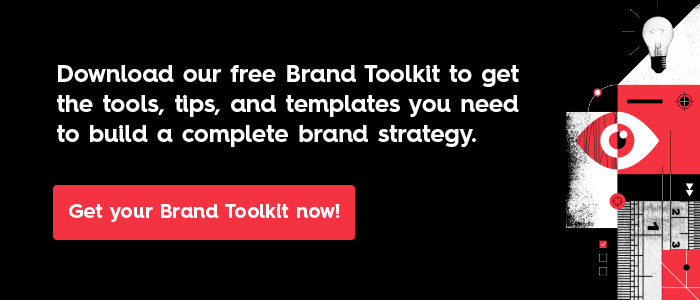When people ask us why it’s important to build a brand strategy, it’s a loaded question. Can you run a business without a brand? Sure. But will you be memorable? Will people feel affection for you? Above all, will you last? Without a strong brand, the odds aren’t in your favor.
“Your brand is what other people say about you when you’re not in the room”
—Jeff Bezos
Branding matters not just for vanity or for aesthetic reasons. It matters because the business paradigm has shifted (and continues to shift). Old channels of communication aren’t as effective as they once were, people’s expectations have changed, and as a result the walls between businesses and people are breaking down. Transparency, trust, and connection are the secrets to longevity—and it’s difficult to cultivate those without a brand.

5 Reasons Why You Need to Build a Brand Strategy
Building a brand takes work, but it has a tremendous payoff, now and later. From being able to charge premium prices to cultivating loyalty, here are the key ways in which having a brand helps your business.
1) Differentiation
It goes without saying that pretty much every market everywhere is full of tough competition. Marketing is tougher than ever, too. With so many channels, it’s harder and harder to be seen and heard. A brand strategy is key to cut through that noise, helping you understand who you are, why you exist, and how to communicate this effectively. The more consistently and cohesively you present your brand, the easier it is to stand out from competitors.
This is also true no matter your size or industry. Juggernauts like BMW and Coke have built branding empires, but branding isn’t exclusively for mega corporations. Mom-and-pop small businesses can build brands that are sensations, too.
In fact, for many, being the little guy is a huge part of their identity. For example, Sqirl is a small LA-based cafe famous for their signature jams. They’ve built a cult following (and even a jam of the month club) by delivering on their brand promise: fresh jam made from locally sourced ingredients.
(Note: One common trend we see is brands focusing on growth hacking over brand building. However, this approach sacrifices long-term gains for short-term growth.)
Example: Sqirl’s emphasis on unique, delicious flavors has helped the brand earn fans from near and far.
View this post on Instagram
2) Relationship Building
In the last decade or so, we’ve seen a huge shift in marketing, from interruption marketing—the one-way conversation of advertising—to engagement marketing, which is all about interaction, connection, and relationship building.
To find and attract the people who will become loyal, lifelong fans, you need a strong, authentic brand identity that accurately reflects your beliefs and values. This is more important than ever, as people want to support brands whose values align with their own.
According to the 2018 “Global Consumer Pulse Research” report by Accenture:
- 63% of surveyed global consumers prefer to purchase products and services from companies whose purpose reflects their own values and beliefs.
- 62% say their purchasing consideration is driven by a company’s ethical values and authenticity.
A strong brand strategy provides the blueprint for how you communicate. The more transparent you are, the more people will gravitate to you—and, most importantly, trust you. That trust is the key to building a lasting relationship.
Example: A strong brand strategy also helps you put your values into practice. For example, during the COVID-19 crisis, brands like Honest have made a significant effort to show up for their communities. Thus, these brands are most likely to earn people’s support in the long run.
3) Pricing
Why are you willing to shell out more for Nike shoes or Apple products? It’s not just because they’re cool. It’s because they’ve created a premium brand experience, from their advertising to their packaging.
Try on a pair of Nike sneakers and you feel like an athlete. Pick up an Apple tablet and you feel like an artist. These brands have created a brand experience so strong it has become part of their DNA. The result? People perceive them to be the gold standard in their industries, and their pricing reflects that.
With a strong brand strategy, you can ensure you’re delivering on your brand promise at every touchpoint, helping you create a brand experience that is worth paying a premium for.
Example: Minimalist sneaker brand Common Projects charges a hefty premium for their shoes. But they have created a strong brand identity to back it up, reinforcing their obsession with simplicity, design, and quality in everything—even their minimalist website.

4) Recruiting
Trying to connect with the people who will eventually use or buy your product or service is a crucial part of any healthy business, but there’s something else that greatly influences your success: the people who work for you. A brand doesn’t exist alone. It’s a living, breathing entity formed by the people who work for it.
If your culture is toxic or your workplace unsafe, your brand won’t last. Why?
- First, because authenticity and transparency are vital to any community you build. (According to the Accenture report, 65% of people are drawn to brands that treat their employees well.) If you’re not practicing your beliefs, your brand will get dragged painfully and publicly.
- Second, you will fail to attract and maintain talent, which will hurt you in the long run.
A strong brand strategy lets you clearly articulate your purpose, vision, mission, and values—the core principles that keep people connected and engaged.
Right now, is your team happy and satisfied? Do they know why your company exists and how they contribute to it? Do they feel fulfilled when they come to the office? If the answer is no, it’s time to revisit your brand strategy,
Note: Culture marketing is a great way to tell your brand story and attract potential talent. If you haven’t experimented with it before, here are a few tips to turn your culture into engaging content.
Example: Dropbox is particularly adept at employer branding, establishing themselves as a brand that is creative, inclusive, an worthwhile to work for—and with.
View this post on InstagramEmpowered women empower women. #InternationalWomensDay #WomensHistoryMonth
5) Decision Making
It can be hard to make the right choices for your brand in the long term if you’re facing challenges today. This is why so many brands overreact or make impulsive decisions when trouble comes along—often to their detriment.
Whether you’re facing an economic downturn, a bungled launch, or internal friction, there are always stresses and strains that can challenge your brand, but a brand strategy helps you navigate these difficulties much more effectively.
When you have a clear understanding of why your brand exists, what you’re trying to achieve, and what you believe in, you have a North Star to help you make both small and large decisions day to day. Is that new blog on brand? Should you collaborate with that vendor? Are you positioning yourself advantageously for the future? A documented brand strategy keeps you moving in the right direction at all times.
Example: When we face challenging moments as a brand, we think of our Five Columns: the core values that define us. These principles have influenced every aspect of our strategy, from the type of businesses we do and don’t work with (sorry, fracking industry) to the projects we create to help our larger community.

How to Build Your Brand Strategy
Building a brand doesn’t happen overnight; it’s an ever-evolving process. But there are intentional moves you can make to get yourself on the right track. If you’re ready to revamp your brand strategy and tell your brand story more effectively, try these next steps.
- Identify your Brand Heart. Every brand is built on a set of core principles. Download our free Brand Heart workbook to identify your purpose, vision, mission, and values.
- Complete your full brand strategy. You need a strong foundation to build upon, and a brand strategy gives you just that by helping you identify your values, goals, and more. If you haven’t completed a brand strategy, here’s our guide to do it.
- (Re)align your content strategy. Your content strategy is technically part of your brand strategy, but many brands are working with a content strategy that is disconnected from those larger goals. For more on creating a cohesive brand, find out what you need to include in your content strategy and how to document it properly.
- Create a visual identity that reflects your brand. A visual identity is another tool to communicate, so make sure yours includes everything you need. Use our handy checklist to design a comprehensive identity. If you think you need a rebrand, here’s how to know if you should do it or not.
- Refine your brand messaging. You need consistent messaging to tell a powerful brand story. Use this messaging framework to ensure your tagline, value prop, and messaging pillars are aligned.
- Tell stories that matter. Customers are people with their own thoughts, interests, desires, fears, and feelings. Focus on creating a brand experience that taps into those feelings, whether you’re helping them solve a problem or enhance their life. To start, here are a few ways to share your brand story.
Of course, we know it can be tough to build a brand from scratch, especially if you don’t have much bandwidth or resources. If you need to bring in an agency for reinforcements, here’s how to find one. We’re always happy to talk shop, too.





